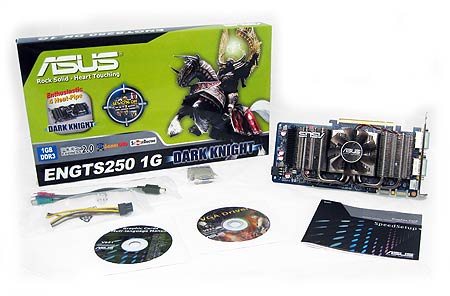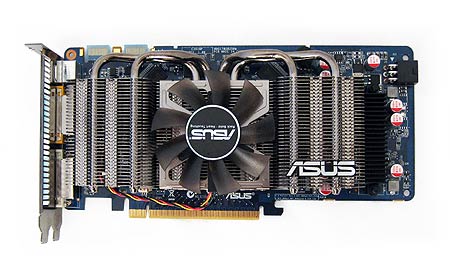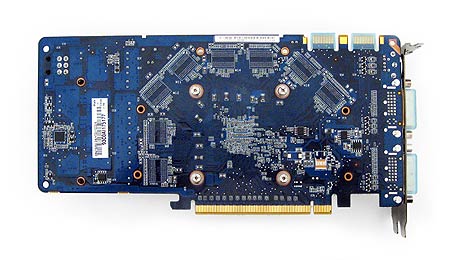GeForce 9600 GT/GTS 250/GTX 260 Non-Reference Roundup
Asus ENGTS250 Dark Knight 1G
The GeForce GTS 250's performance is a cut above that of the GeForce 9600 GT. Asus’ iteration of its GeForce GTS 250 Dark Knight sports 1 GB of RAM in order for the card to remain competitive with newer cards, like the Radeon HD 4770. Asus’ Dark Knight still has the same non-reference cooler as its predecessor, keeping temperatures manageable and the noise level low.
Although Asus doesn’t seem to promote it aggressively, one feature this card has that makes it stand out is efficiency. It has variable 2D/3D clock speeds, like many other cards, but the 2D clocks allow the card to use the least amount of power compared to those in this roundup when used in 2D mode. More on this later.
The ENGTS250 1G Dark Knight comes in an attractive retail package. In addition to the usual driver and utility CDs, there is a Molex-to-PCIe power adapter, a component video output adapter, a DVI-to-VGA adapter, and a DVI-to-HDMI adapter. Once again, we’re unhappy to see that there are no SLI connectors in the bundle (Ed.: these should be included with your SLI-certified motherboard, though).
One extra bonus Asus includes is a 10% off coupon for up to five games or applications, which can be purchased from nZone.com. We were disappointed that a top-tier title wasn't included in the bundle, but at least this lets the buyer choose what he or she wants, instead of being stuck with an unwanted game.
As for the PCB itself, at about 9” long, it’s a little smaller than the GeForce GTS 250 reference build. It requires the standard six-pin PCIe power cable. The similarities to the reference card end there, as this ENGTS250 DK is equipped with 1 GB of memory and sports a powerful custom GPU cooler with four heat pipes. The cooler is large, causing the board to populate two expansion slots. The only downside to this arrangement is that heated air won't be expelled out of the back of your enclosure, as it would with the reference blower.
Get Tom's Hardware's best news and in-depth reviews, straight to your inbox.
Current page: Asus ENGTS250 Dark Knight 1G
Prev Page Gigabyte’s GV-N96TSL-1GI And GV-N96TZL-1GI: Identical PCBs And Overclocking Next Page Asus ENGTS250 Dark Knight 1G, Cont’dDon Woligroski was a former senior hardware editor for Tom's Hardware. He has covered a wide range of PC hardware topics, including CPUs, GPUs, system building, and emerging technologies.
-
Mottamort I was rather disappointed with this article. Not the article itself but with the slightly misleading Title/Intro. When clicking the article I thought I was going to find a massive battle between these vendors on different tiers, instead you show us different instances of 2 slightly different cards of the same type from one vendor....if that makes senseReply
I mean you have Gigabyte vs Gigabyte in the 9600gt section, Asus vs Asus in the 250 section and so on.
:-/ -
dragonsprayer Great articleReply
i wish it had more cards, i think you need 4 parts, try some back cards like the 4870x2 darkknight? good stuff as always!
thx! -
crisisavatar wow how is the gts 250 performing so close to the gtx 260 wasn't the gtx 260 20% faster ?Reply -
enterco It's not clear to me why are you comparing '3dmark score' when you should post 'GPU score'.... It's a graphics card comparision, not platform comparision.Reply -
randomizer entercoIt's not clear to me why are you comparing '3dmark score' when you should post 'GPU score'.... It's a graphics card comparision, not platform comparision.Nothing but the cards is changed so you're not comparing platforms.Reply -
acasel We cannot see clearly the bang for the buck card there if we ain't seeing some ati cards like the 4770 and others..Reply
The drop down menu sure is fast... :-) -
enterco randomizerNothing but the cards is changed so you're not comparing platforms.Sure. A reason more to show GPU score. 3dmark score is too much influenced by CPU's power, and it's no longer relevant, the way it used to be once...Reply
By using a Quad Core and a low-performing GPU you can achive same 3dmark score as using a dual core combined with a considerably stronger GPU, 3dmark Vantage gives too much credit to CPU. But the overall FPS in games it's often higher in the second case: dual core + better GPU. -
marraco Recent review showed the 260 being neck to neck with the 4870; both in price and performance, those cards are in the same point.Reply
Since my 8800GT should be between the 9600 and the 250, I guess that the best upgrade path is to buy a second 8800GT, reaching probably 260/4870 performance.
I searched the web for 8800GT SLI benckmark running in i7 920, but got no one single review...
I think that tomshardware should review non up-to-date cards as the 8800 and the ATI equivalents, in crossfilre/SLI, since for many users, it should make sense to buy a second card that to upgrade to a 260/4870.
older reviews on those cards does not accounted for the scalability on I7 x58 platform, and probably ATI and Nvidia dedicated more time tweaking drivers for newer cards, so maybe the 8800GT does not perform well today (the SLI on core 2/Quad did not worked very well in the past)



